This post may contain affiliate links.

If you’ve decided to start keeping fish, an aquarium is a big decision, since you are essentially buying a house for your sea creatures; therefore, you want it to be well-constructed, safe, and durable. The type and size of the aquarium you choose will also drive what other additional equipment and accessories it may be important for you to consider. Do you need a mat for your aquarium?
You need an aquarium mat. This would benefit a rimless aquarium to protect the bottom from scratches and ensure your tank is true. However, aquariums with a floating base, where there is a rim around the bottom to not rest directly on a surface, would not benefit from additional support or padding.
Read on to learn more about rimless tanks, why mats are important for them, and the major characteristics of a good mat.


Why Do You Need to Manually Level Your Aquarium?
If the surface your aquarium is sitting upon is not level, you can run into real structural problems. Before filling your aquarium all the way up, it’s important to manually level the furniture or stand it is sitting upon. Here’s some of the science behind why this is important.
The water in a tank applies a force of pressure on the bottom and walls of the tank. The pressure is a factor of the water’s depth, so the deeper the water, the more pressure. That’s why the bigger your tank, the more important it becomes to ensure its level.
If your aquarium is not level, the water is at a different depth from one side to the other or from the back to the front. Water can’t bend or twist but instead applies pressure uniformly. Think of the shallow end of a pool and the deep end.
If you swim along the bottom of the shallow end, the water pressure pushing down on you is not as great as when you swim along the bottom of the deep end. That’s because of the depth of the water.
The same thing applies to an aquarium that is not sitting level. There is a deeper end where the pressure of the water is greater. This extra pressure pushing on a surface causes stress and, over time, can become too much for the glass, causing it to crack.
Obviously, this can be catastrophic for the tank, the marine life living in your tank, and the surrounding area that could be drenched by a tankful of water.
The larger the aquarium, the more precise your level needs to be because of the force applied by the greater amount of water.
Here’s a quick overview of the major steps to level the stand or furniture for your aquarium:
- Place a level on the stand or furniture your aquarium sits upon.
- Using a mallet and shims, carefully pound the shims under the low side to raise it to a level height.
- For maximum stability, be sure to place shims at about six-inch intervals along the entire edge of the furniture or stand.
- Using your level, ensure the bubble shows a level reading.
Using an Aquarium Mat to Fine-Tune Your Leveling
An aquarium mat is a low-cost investment. In fact, many rimless tanks come with a mat, so be sure to carefully inventory the package contents if you decide to buy a rimless tank. Some people mistake the mat for packing material and throw it out! There are two reasons you might consider investing in one.
First, even after you’ve leveled your aquarium stand or the piece of furniture it is sitting upon, you may still have small gaps between the bottom of your aquarium and the surface it is resting upon.
If your aquarium is not resting upon a frame or rim, it is rimless; the bottom does not have an edge it rests upon but instead sits directly on the surface it is resting upon. It must sit completely flat. That can be difficult to achieve since often the surface has bumps and uneven spots.
These cause gaps between the bottom of your aquarium and thus cause pressure points. Placing an aquarium mat under your tank will fill these gaps as the weight of the tank presses down on the foam mat pushing the material up into any gaps to fill them.
The foamy mat acts as a mattress for the bottom of your tank, cushioning minor unevenness and thus leveling out the pressure evenly across the bottom of your aquarium.
Second, the mat acts as protection from scratches should you bump your tank or shift it just a bit. Not only scratches on your tank, which may degrade the beautiful view you have of your marine life but also scratches to the surface your tank is sitting upon.
Since there is no frame or rim, the glass bottom directly connects with the supporting surface. Any tiny bits of debris that may be on that supporting surface can scratch the bottom of your aquarium if the aquarium is bumped or shifted in a tiny bit.
Why Choose a Rimless Tank?

The short answer is rimless tanks are really good-looking. Your tank will probably be a focal point in whatever room you decide to put it in, so you want it to be a pleasing addition to that space.
Additionally, a rimless tank is pretty to look at, but the view of what’s inside is better, too. With only reinforced glass and no extra trim or braces, the unobstructed view you have as you watch your sea creatures swimming around in your tank is fantastic.
Because rimless tanks don’t have the outside bracing of traditional glass tanks, the glass is thicker to support the water’s pressure on the sides and bottom of the tank. To increase the glass’s overall strength on a rimless tank, the glass is bonded with silicon.
Further, many rimless tanks use low iron glass making it purer glass. This purity means your glass won’t have the green hues caused by the presence of iron oxide in the less pure glass. Iron oxide seeps in from the sand that glass is made from or even from the glass’s container. A clearer glass means you will see the truer colors of sea life in your aquarium.
What to Look for in an Aquarium Mat?
There are lots of aquarium mat choices out there to buy, and installing one is relatively simple, as seen in this video:
The important features of a good mat are:
- It is waterproof. You don’t want to have to worry about dripping water onto a surface that could rot. You will end up having to empty your aquarium, at least in part, to lift it and replace the rotted mat material.
- It is made from a material that is cushiony or spongy. This allows it to give so it can fill in the spaces from the small gaps.
- It is easy to cut since you will want to be sure it fits perfectly under your aquarium.
- It is a dark color, like black, so that it doesn’t call attention to itself. You want to look at the marine life in your aquarium, not what’s under your aquarium.
Wrapping Things Up
Spending the money on a waterproof, spongy aquarium mat is important if you have a rimless tank where the tank’s bottom sits directly upon a surface. The mat helps ensure your aquarium is level, reducing possible pressure points caused by gaps and unevenness in the surface, and will also protect the bottom of your tank and the surface from scratches.
Related articles:
